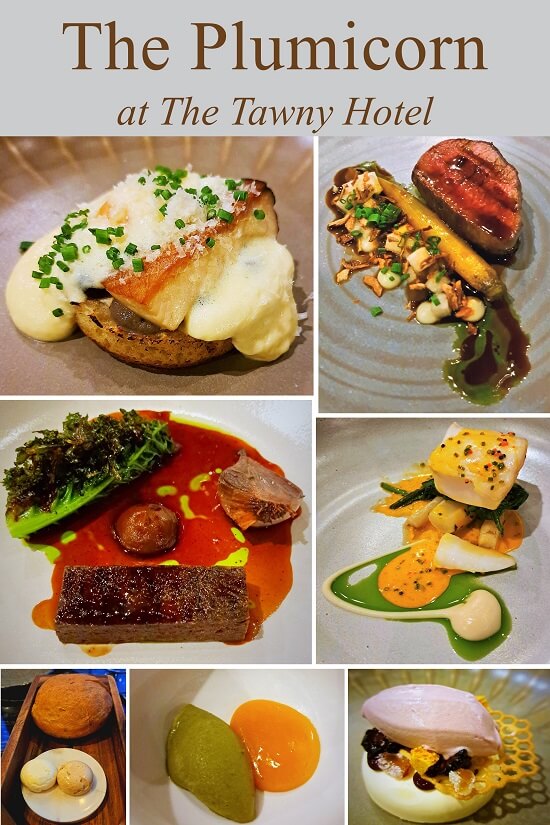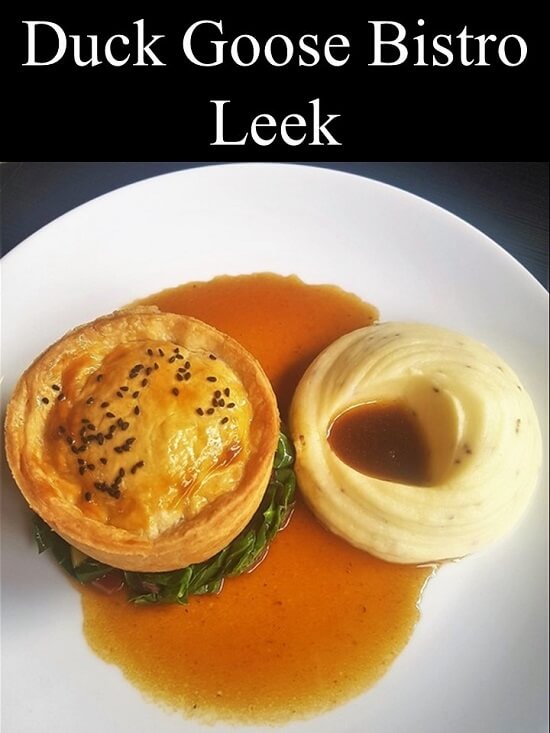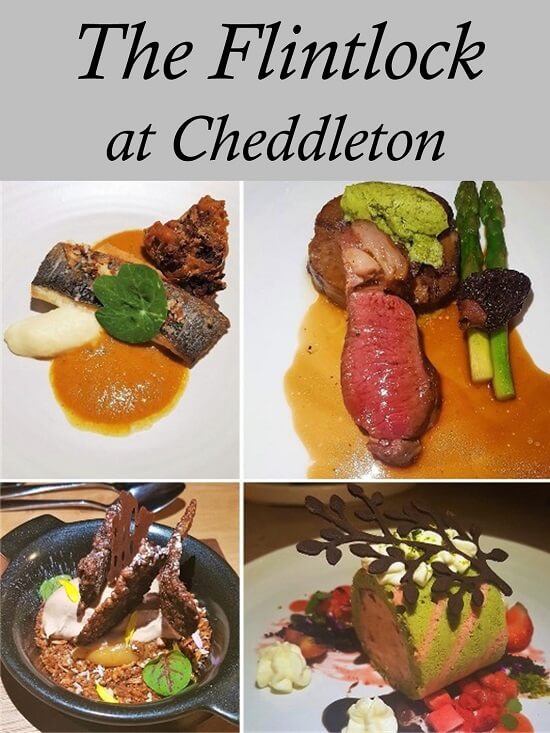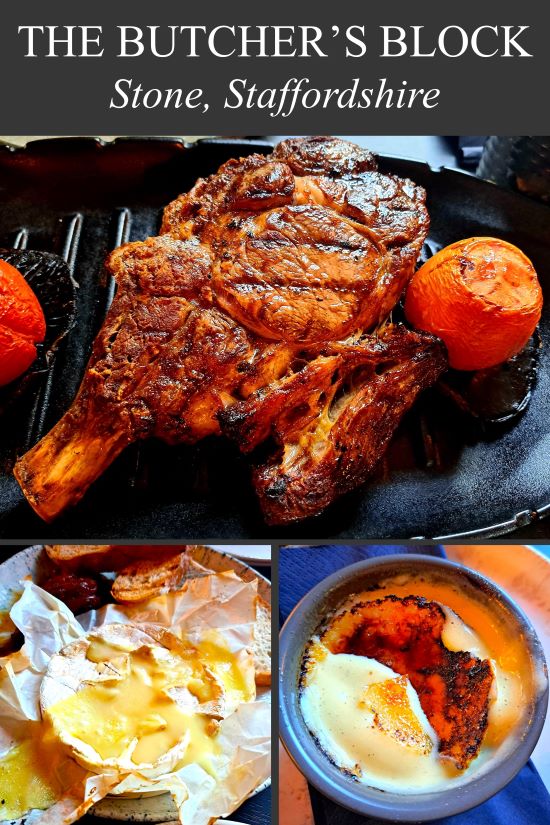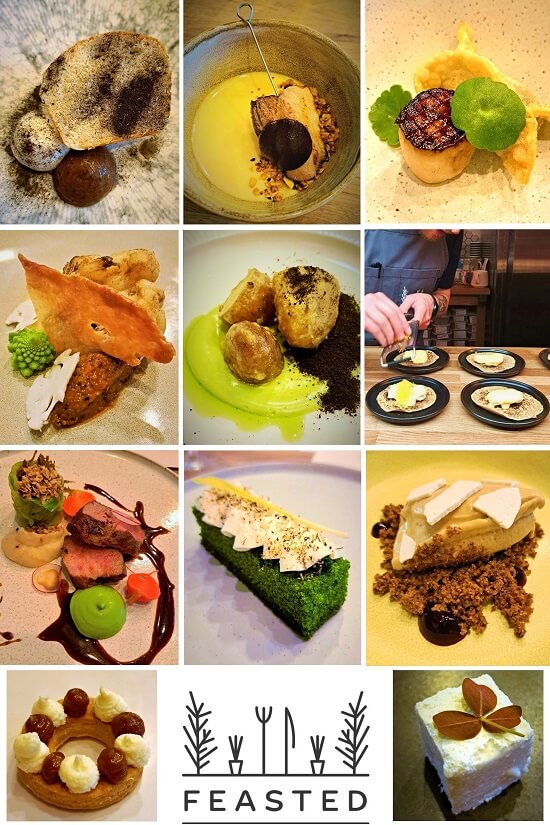Filipino Street Food at The Three Horseshoes
Filipino street food has come to north Staffordshire. Popular country inn and spa The Three Horseshoes is currently serving up a range of tasty plates created by their team of Filipino chefs. Choose one of six dishes to enjoy as a starter, three as a main course or, highly recommended, sample the whole range by sharing tapas-style. With most dishes just £7, trying something new to the region needn’t cost a packet.
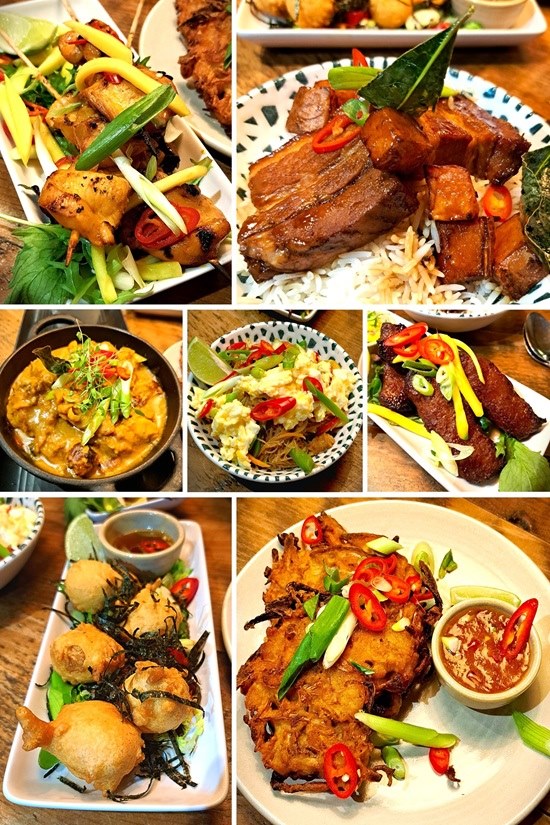
THE THREE HORSESHOES
Run by the same family since 1981 and expanded in 2015 to include the Mill Wheel Spa, The Three Horseshoes sits on the edge of the stunning Staffordshire Peak District. With various vantage points to view the magnificent moorlands landscape, including its patio and luxury guest rooms with private gardens and hot tubs, it’s unsurprising that The Three Horseshoes is also a popular wedding venue and holiday spot.

But, living just a fifteen-minute drive away, I know this country inn best for its food. The bar and restaurant serves up a winning combination of pub classics executed to a high standard plus modern British dining. In fact, as well as regularly recommending it on social media for things like its perfect fish and chips, brilliant carvery, and a particularly good value steak night, I’ve already written TWO full reviews on this blog. So, you may ask, why another one? Well, I was invited to try something a bit new and different to this area and highly recommend it.
FILIPINO STREET FOOD AT THE THREE HORSESHOES
When The Three Horseshoes invited me to try their Filipino street food menu, I must confess I didn’t know they had one. But turns out it’s been running for almost a month. There are seven dishes (six at £7 each, one at £8) you can choose as a starter or eat several together tapas-style. There’s also a main course that complements the street food.
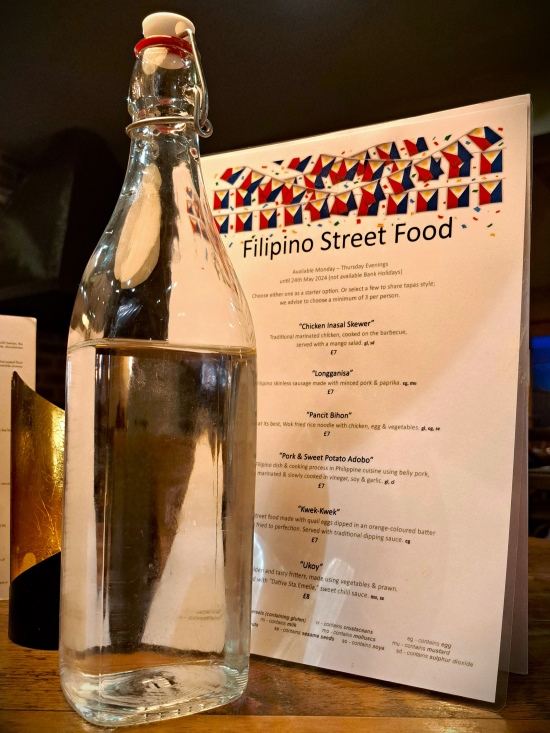
One of the reasons I jumped at the offer was that I really didn’t know a lot about Filipino food. It’s certainly not something I’ve come across here in north Staffordshire anyway. As far as I know, I’ve only eaten Filipino food once. That was many years ago, cooked by a friend who herself was friends with a Filipino woman. She was regularly invited to eat with the family and was inspired to make a few dishes herself. For me, she cooked some gorgeous lumpia (the Filipino version of Chinese spring rolls) and a richly flavoured take on dinuguan with belly pork and black pudding.
But, thanks to a team of Filipino chefs at The Three Horseshoes, we can all now enjoy a taste of those flavours.
Street food dishes are currently available Monday to Thursday evenings, Bank Holidays excepted, until 24 May 2024.
THE DISHES
Even if you’re completely new to Filipino food, you’ll probably find lots that’s familiar. And especially if you’ve eaten food from other Southeast Asian countries such as Thailand, Vietnam, Indonesia, or Malaysia. Added to the local cuisines are influences from the Philippines’ long history of trade (for example with China) plus over two centuries of colonization by Spain.
Doing a little research before going along, I discovered the word pulutan. Like Spanish tapas, pulutan were originally snacks to accompany drinks. But, also like tapas, often now means several smaller dishes eaten together as a larger meal. And that’s exactly what my guest and I did.
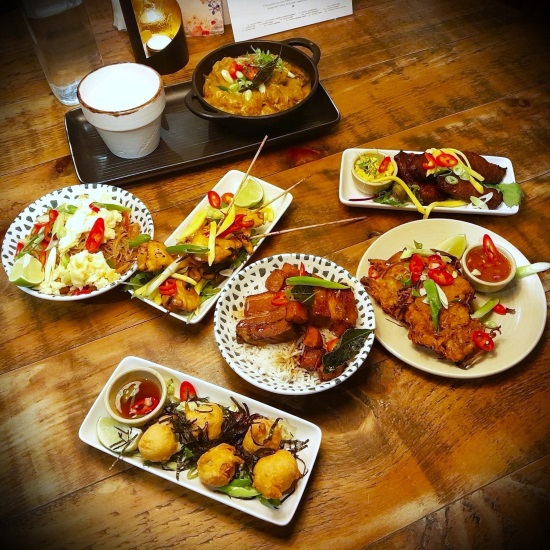
The dishes all came out together, making a wonderfully appetizing spread. Added to those was a main course of curry and rice (sitting at the top in the photo above) which I’ll also tell you about.
CHICKEN INASAL SKEWERS (£7)
If you feel you want to ease yourself into the new world of Filipino food, then these tasty kebabs would be a great choice. Pieces of chicken breast had been marinated and then grilled (inasal apparently means to roast or grill). The flavouring was subtle, a little sweet, a little tangy, allowing the flavour of the chicken to come though.
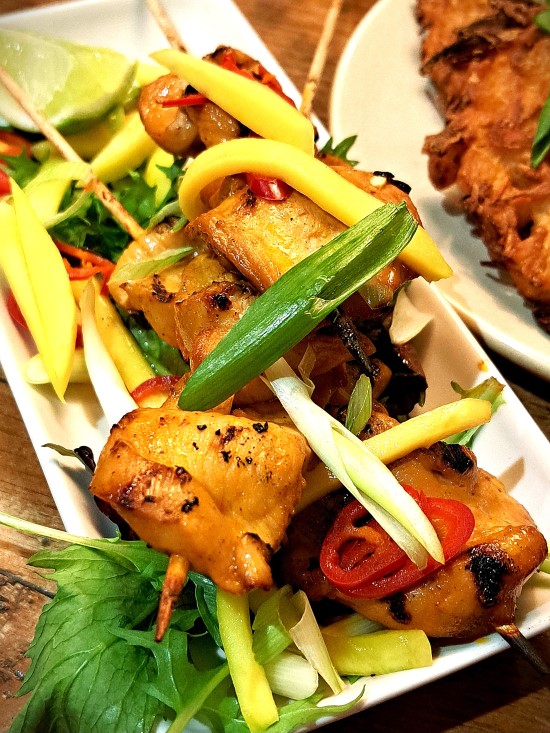
The meat was cooked well, soft and nicely juicy. Also on the platter were salad leaves, spring onion, slivers of juicy, sweet mango, and a wedge of lime for squeezing over. As with all the dishes, there were slices of fresh red chilli to add as much or as little heat as you like.
LONGGANISA SAUSAGE (£7)
This was a skinless sausage made with minced, very close-textured pork. Flavoured with paprika, I wondered if longganisa has some link to the Philippines’ colonial Spanish past and chorizo sausages with smoked paprika. The Portuguese version, linguiça, even sounds similar. But the difference here was a very sweet taste.
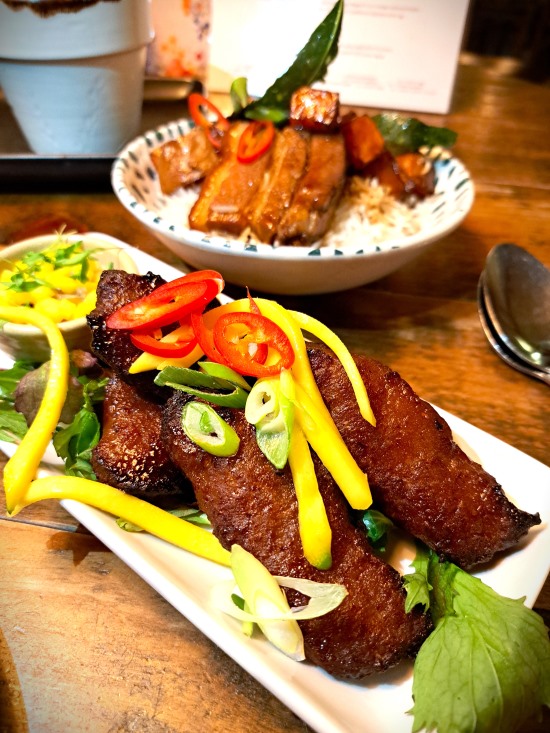
Just like several other dishes, the four generously sized sausages came with their own dipping sauce. This one had a subtle flavour with very finely chopped vegetables and mango in a lightly creamy dressing. But, to counteract the sweetness of the meat, I found I preferred it with the tangy, vinegary dip from the fourth dish I tell you about in a minute.
Like the chicken skewers, this dish was garnished with leaves, spring onion, mango, and chilli slices.
PANCIT BEHON NOODLES (£7)
The next dish was fried noodles with chicken, egg, and vegetables. I’ve already mentioned the influence of China and it seems that’s how noodles (and soy sauce) came to the Philippines. According to my newfound knowledge, pancit refers to various Filipino noodle dishes, apparently deriving from ‘pian i sit‘ meaning something cooked quickly. And behon indicates it contains rice noodles rather than, for example, round egg noodles which would make it pancit canton.

At the bottom of the bowl was a generous portion of well-flavoured thin noodles with vegetables like peppers and carrots plus little morsels of chicken. I’d assumed the egg element would be incorporated into the noodles, either scrambled or omelette strips. Instead, fluffy scrambled egg sat on top along with the now-familiar garnishes. I liked this approach as it gave variety to the dish instead of the egg being coated in the same flavours as the stir-fried elements.
PORK & SWEET POTATO ADOBO (£7)
The influence of our next dish was Spain. Adobo is a Spanish word referring to various types of marinade, in this case including vinegar. To these are added garlic, bay leaves and, back to China again, soy sauce. Containing two decent sized slabs of belly pork, plus cubes of sweet potato that had been slowly cooked in the marinade, this was one of my favourite dishes.

The meat was beautifully soft and tender. The fat (don’t expect crackling) was lovely and soft too. The sweet potato was nicely charred with its outer layer almost chewily caramelized. The flavours, a lovely combination of savoury, sweet, and sour, were hugely enjoyable. Underneath, taking up some of the delicious juices, was a good portion of perfectly cooked rice. Again, there was fresh chilli to add if you wanted heat.
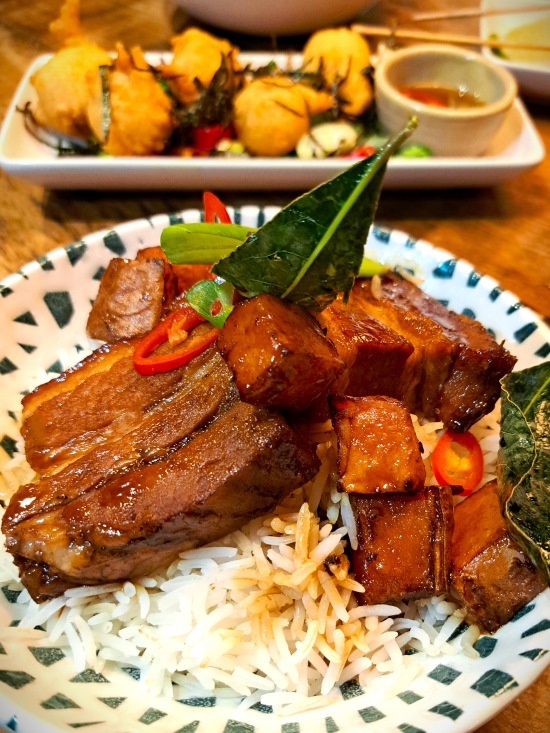
‘KWEK-KWEK’ EGGS (£7)
I’ve tried to find the origin of this strangely worded dish but am still not entirely sure what kwek-kwek means. I think it refers to the sound of a bird (like ‘cheep-cheep‘ or ‘quack-quack‘). This makes sense as it’s boiled eggs, battered and fried. These dinky little ones are quails’ eggs which, to me at least, taste just the same as hen’s eggs. But these are much cuter and make great finger food.
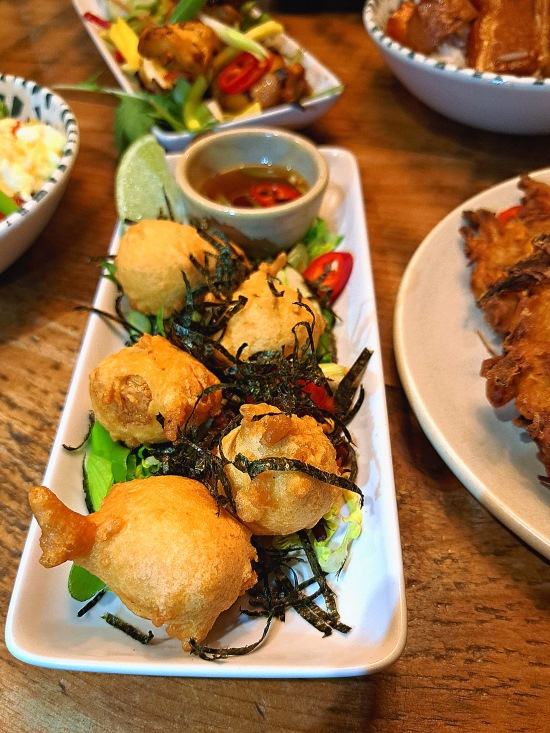
The batter is traditionally orange as it’s coloured with the spice annatto. Our kwek-kwek had a quite natural looking light golden batter. For dipping there was the tangy, vinegar-based sauce I’d used for the longganisa sausage. It was a good match for the simple eggs too.
UKOY PRAWN FRITTERS (£8)
The last of the street food dishes turned out to be another of my top favourites. Wonderfully crisp, tasty, and moreish prawn fritters. There are versions of prawn fritters in loads of different countries, including the tortillitas de camarones of Spain. Whether Filipino ukoy fritters derive from its colonial past or not, I don’t know. But what I can tell you is that I could eat a heap of them!
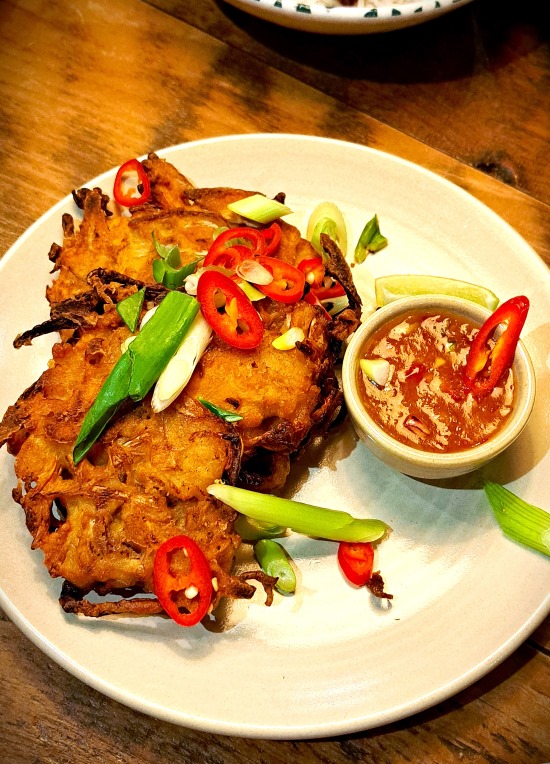
Besides prawns, the golden batter held vegetables including tender beansprouts. I thought these made a lovely contrast to the crunchiness. The fritters themselves were plainly seasoned but with a little heat. There was also good quality sweet (but not too sweet) chilli sauce on the side for dipping. If you like prawns, then this one is a must!
MAIN COURSE DISH: PHILIPPINE COCONUT CHICKEN CURRY
I’d been invited to eat the whole range of street food dishes, but when we arrived were encouraged to also try a Filipino main course recently added to the regular menu. Oh okay, if you insist! Philippine Coconut Chicken Curry (£17.95) came in a generous portion in an attractive, two-handled bowl, a pot of fragrant rice on the side.
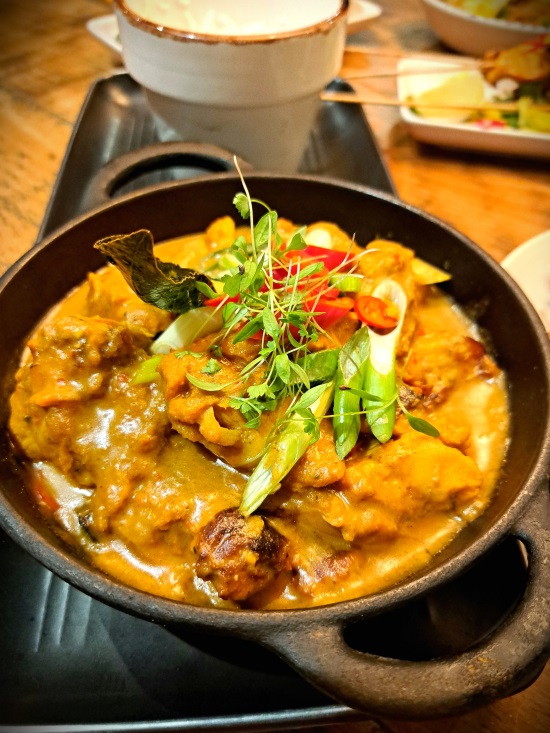
The pieces of chicken, presumably boneless thigh, were cooked perfectly: beautifully soft and tender. The mildly spiced sauce, rich with coconut, also held a variety of vegetables: peppers, carrots and, best of all, potatoes that seemed to have been roasted. Try my own Chickpea, Potato & Coconut Curry to discover the extra dimension roasted potatoes bring to a coconut curry.
If you’re not familiar with Filipino food, but like milder, creamy curries then I think you’ll love this.
FILIPINO STREET FOOD: SOMETHING NEW AT A GREAT PRICE
Knowing next to nothing about Filipino food, I jumped at the chance to try the street food at The Three Horseshoes. And I wasn’t disappointed. If you’ve eaten Chinese or Southeast Asian food before, then you’ll be familiar with many of the flavours. But the influence of other cuisines like that of Spain added some interesting twists.
If you can, I highly recommend you try all the street food dishes by sharing and eating tapas-style. At £43 for a generous amount of tasty food that you can’t get anywhere else in this part of the country, I reckon that represents good value. It’s suggested that you order three dishes per person so, with two people sharing, that’s £21.50 per head. But I think it might even stretch to feeding three smaller appetites.
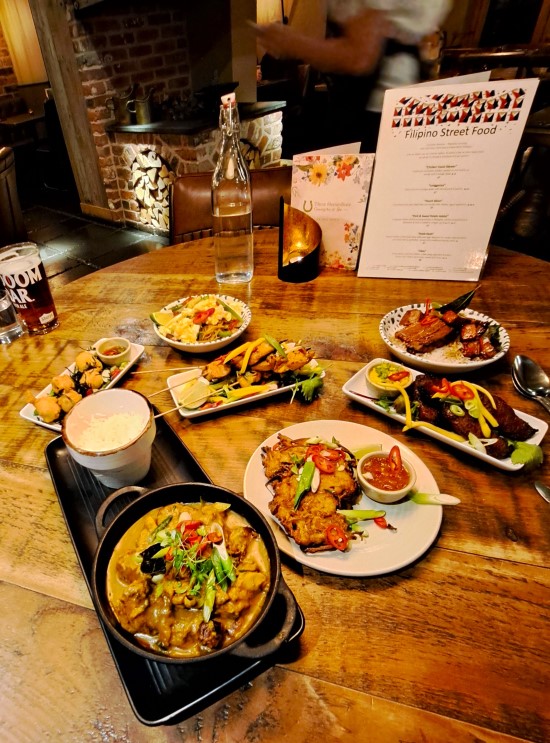
Of course, you can also try any of the street food dishes as a starter before something from the regular menu. For those looking for simple flavours, then the chicken skewers or kwek-kwek eggs should fit the bill. And don’t forget that lovely main course Philippine Coconut Chicken Curry. As we’d already pretty much cleared our plates of the street food, we couldn’t quite manage to finish the curry. But the always friendly and efficient front of house team were happy to get it packed up for us to take home.
As I write, it’s planned that the Filipino street food menu will run until 24 May 2024 on Monday to Thursday evenings (not Bank Holidays). But I’d love to think that if lots more of you went along to try these tasty, good value dishes, it might just stay around a little longer. Book your table here.
PRICES AND MENUS CORRECT AT TIME OF WRITING
ALL PHOTOS © MOORLANDS EATER & NOT TO BE REPRODUCED WITHOUT PERMISSION
DISCLOSURE
I was invited by The Three Horseshoes to try their Filipino dishes free of charge for myself and one guest. All drinks and staff tips were paid for by me. As always, my review is an honest one based on my own experience. When invited to dine for free, the venue is always made aware that I only write about what I genuinely recommend so I cannot guarantee a review. Where a product or service has been provided for free, I always include a disclosure such as this in the blog post containing my review.
MORE EATING OUT RECOMMENDATIONS



